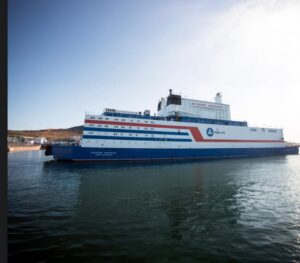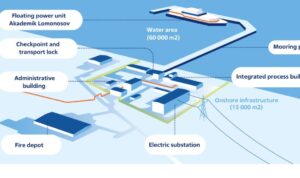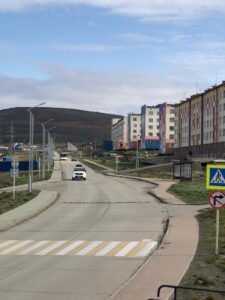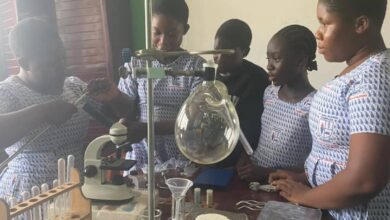Russia’s Floating Nuclear Power Plant Transforms Energy Landscape in Arctic Chukotka

|
Getting your Trinity Audio player ready...
|
By Edward Graham Sebbie
Russia has achieved a groundbreaking feat in global energy innovation with the successful operation of the world’s first floating nuclear power plant (FNPP), ushering in a new era of small modular reactor (SMR) technology designed to deliver clean and reliable energy to remote regions.
The Akademik Lomonosov, a transportable floating power unit constructed by Rosenergoatom JSC, a subsidiary of Rosatom, has been supplying electricity and thermal energy to the isolated Arctic town of Pevek and surrounding areas in Russia’s Chukotka region since 2019.  With a generation capacity of up to 77 megawatts (MW) of electric power and 300 MW of thermal power, the FNPP has not only replaced the aging Bilibino Nuclear Power Plant but also drastically reduced the region’s carbon footprint.
With a generation capacity of up to 77 megawatts (MW) of electric power and 300 MW of thermal power, the FNPP has not only replaced the aging Bilibino Nuclear Power Plant but also drastically reduced the region’s carbon footprint.
Constructed at the Baltic Shipyard in Saint Petersburg, the FNPP was towed over 9,000 kilometers through Scandinavian neutral waters to Murmansk for reactor fueling, before being transported to its final mooring site in Pevek. There, the unit was integrated into purpose-built onshore infrastructure that transmits electricity and heat from the plant to the town and surrounding mining communities.

Rosatom officials emphasize that the Akademik Lomonosov project demonstrates the viability of modular, scalable nuclear solutions for hard-to-reach territories. The FNPP’s load-following capability allows it to adjust output based on demand, while its compact design suits regions with limited infrastructure.
Environmental data indicates a substantial impact: since 2021, annual CO₂ emissions in the region have decreased by approximately 126 tons due to the shift away from fossil fuel sources. Additionally, the FNPP has reported no radiation exposure to the surrounding waters, with growing marine biodiversity recorded in the Pevek sea area.
As part of efforts to deepen global understanding of nuclear energy advancements, a team of visiting journalists from Africa, including this reporter, was taken on a comprehensive tour of the FNPP. The media delegation was first briefed onboard on the construction, operational principles, and safety protocols of the plant. The tour included visits to the operations and control rooms—where plant systems are monitored and managed—as well as the staff accommodation and recreational facilities designed to support the well-being and fitness of the plant’s rotating workforce.

“The FNPP offers a stable, carbon-neutral power solution without contributing to the depletion of natural resources,” a Rosatom spokesperson said. “All operations involving nuclear fuel and waste are securely managed onboard, and the unit’s lifecycle includes eventual decommissioning and site restoration.”
The plant employs a rotational staffing model, with 135 workers living onboard in specially designed accommodation compartments. Each member receives safety and operations certification under Russian maritime and nuclear regulations.
Rosatom is now developing the next generation of SMRs, including land-based reactors such as the RITM-200 slated for deployment in Yakutia. These initiatives build upon the success of the Akademik Lomonosov, which has become a reference project for global SMR advancements.
As global interest in sustainable energy grows, the FNPP sets a precedent for how clean nuclear technology can power remote and underserved regions, ensuring energy security without environmental compromise.






